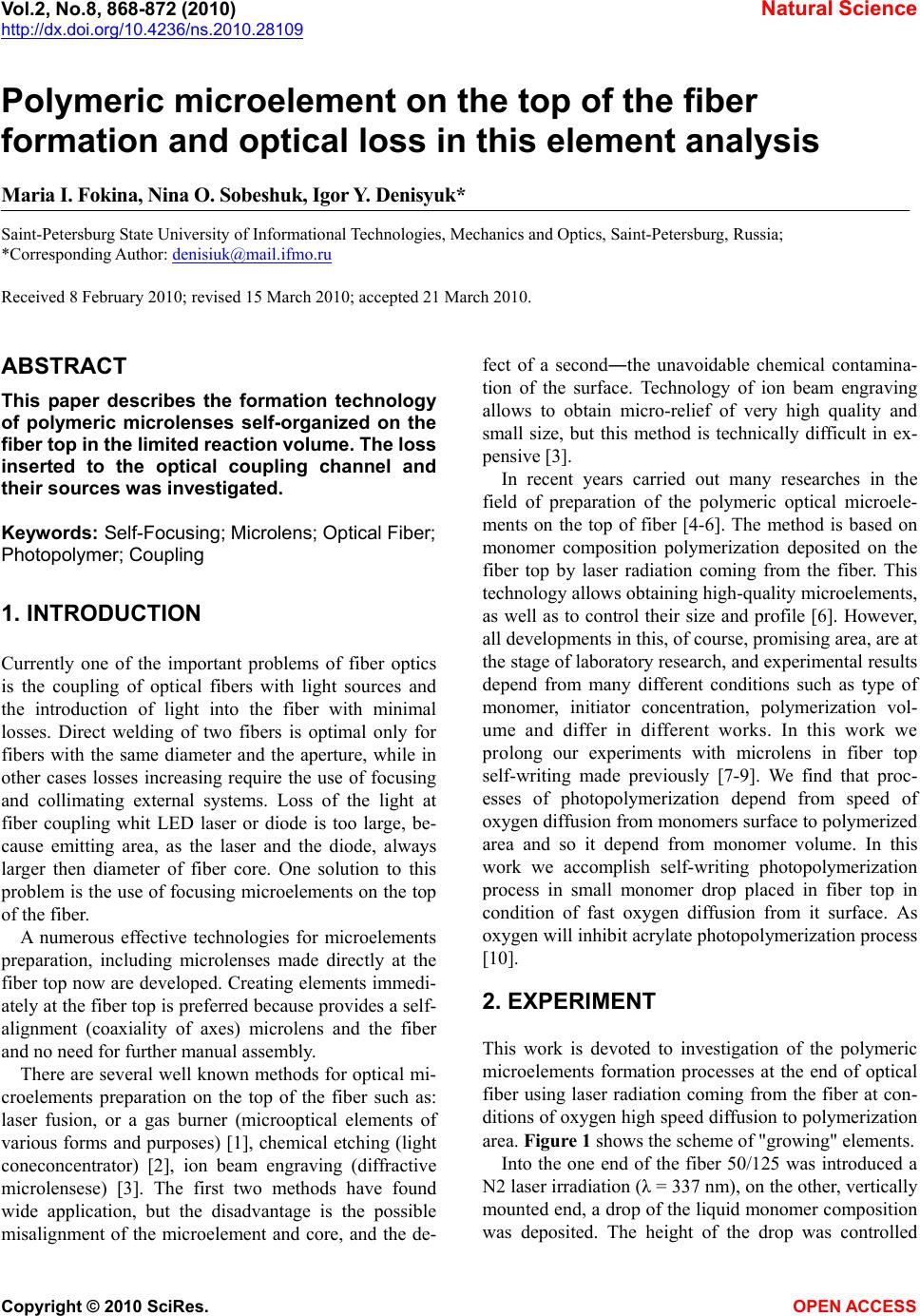
Vol.2, No.8, 868-872 (2010) Natural Science
http://dx.doi.org/10.4236/ns.2010.28109
Copyright © 2010 SciRes. OPEN ACCESS
Polymeric microelement on the top of the fiber
formation and optical loss in this element analysis
Maria I. Fokina, Nina O. Sobeshuk, Igor Y. Denisyuk*
Saint-Petersburg State University of Informational Technologies, Mechanics and Optics, Saint-Petersburg, Russia;
*Corresponding Author: denisiuk@mail.ifmo.ru
Received 8 February 2010; revised 15 March 2010; accepted 21 March 2010.
ABSTRACT
This paper describes the formation technology
of polymeric microlenses self-organized on the
fiber top in the limited reaction volume. The loss
inserted to the optical coupling channel and
their sources was investigated.
Keywords: Self-Focusing; Microlens; Optical Fiber;
Photopolymer; Coupling
1. INTRODUCTION
Currently one of the important problems of fiber optics
is the coupling of optical fibers with light sources and
the introduction of light into the fiber with minimal
losses. Direct welding of two fibers is optimal only for
fibers with the same diameter and the aperture, while in
other cases losses increasing require the use of focusing
and collimating external systems. Loss of the light at
fiber coupling whit LED laser or diode is too large, be-
cause emitting area, as the laser and the diode, always
larger then diameter of fiber core. One solution to this
problem is the use of focusing microelements on the top
of the fiber.
A numerous effective technologies for microelements
preparation, including microlenses made directly at the
fiber top now are developed. Creating elements immedi-
ately at the fiber top is preferred because provides a self-
alignment (coaxiality of axes) microlens and the fiber
and no need for further manual assembly.
There are several well known methods for optical mi-
croelements preparation on the top of the fiber such as:
laser fusion, or a gas burner (microoptical elements of
various forms and purposes) [1], chemical etching (light
coneconcentrator) [2], ion beam engraving (diffractive
microlensese) [3]. The first two methods have found
wide application, but the disadvantage is the possible
misalignment of the microelement and core, and the de-
fect of a second―the unavoidable chemical contamina-
tion of the surface. Technology of ion beam engraving
allows to obtain micro-relief of very high quality and
small size, but this method is technically difficult in ex-
pensive [3].
In recent years carried out many researches in the
field of preparation of the polymeric optical microele-
ments on the top of fiber [4-6]. The method is based on
monomer composition polymerization deposited on the
fiber top by laser radiation coming from the fiber. This
technology allows obtaining high-quality microelements,
as well as to control their size and profile [6]. However,
all developments in this, of course, promising area, are at
the stage of laboratory research, and experimental results
depend from many different conditions such as type of
monomer, initiator concentration, polymerization vol-
ume and differ in different works. In this work we
prolong our experiments with microlens in fiber top
self-writing made previously [7-9]. We find that proc-
esses of photopolymerization depend from speed of
oxygen diffusion from monomers surface to polymerized
area and so it depend from monomer volume. In this
work we accomplish self-writing photopolymerization
process in small monomer drop placed in fiber top in
condition of fast oxygen diffusion from it surface. As
oxygen will inhibit acrylate photopolymerization process
[10].
2. EXPERIMENT
This work is devoted to investigation of the polymeric
microelements formation processes at the end of optical
fiber using laser radiation coming from the fiber at con-
ditions of oxygen high speed diffusion to polymerization
area. Figure 1 shows the scheme of "growing" elements.
Into the one end of the fiber 50/125 was introduced a
N2 laser irradiation (λ = 337 nm), on the other, vertically
mounted end, a drop of the liquid monomer composition
was deposited. The height of the drop was controlled